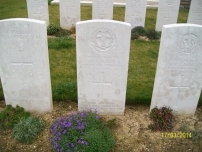| First Name: | Vernon Charles | Last Name: | MANN | |
|---|---|---|---|---|
| Date of Death: | 28/07/1916 | Lived/Born In: | Queen's Park | |
| Rank: | Private | Unit: | Middlesex17 | |
| Memorial Site: | ||||
Current Information:Age-22 1, Brooksville Avenue, Queen's Park
The Battle of the Somme (July-November, 1916) On 1st July 1916 The British Army launched a massive offensive along a section of the front line running north of the River Somme. The French attacked south of it. The first day was a disaster for the British army which suffered nearly 60,000 casualties, 19,000 of whom were killed, and made hardly any inroads into the enemy lines. But the battle had to go on, if for no other reason than to relieve pressure on the French at Verdun where they had been facing the full onslaught of the powerful German Army. So it continued all the way through to November with nearly every battalion and division then in France being drawn into it at some stage. In the end the German trenches had been pushed back a few miles along most of the line but the cost in lives had been staggering. By the end of the fighting in November, 1916, British Army casualties numbered over 400,000, killed, wounded and missing. On 14th July, 1916, a second major offensive was launched, this time against the German second line of defences stretching from Longueval to Bazentin-le-Petit, but unfortunately, after a promising start which saw some important gains on the first day, the British Army once again reverted to a series of uncoordinated attacks, using out dated tactics. Not surprisingly they soon found themselves engaged in a war of attrition as they attempted to push the enemy further back across the Somme battlefield. This was no more so the case than in the fight to capture the village of Longueval and Delville Wood that lay next to it; a struggle that went on for many weeks through the summer of 1916. 2nd Division left the sector to the north of Arras on 20th July, 1916 and proceeded to the Somme battlefield to join in the carnage there. On 25th July they relieved 3rd Division in the southern half of Delville Wood where a great deal of fighting had already taken place turning the wood into a hopeless tangle of undergrowth, fallen trees, remains of trenches and dead bodies. It was not the best of introductions to the Somme. Two days later on 27th July, 1916, Delville Wood was attacked once again, this time by 99 Brigade, 2nd Division, moving up through the southern part of the wood and 15 Brigade of 5th Division attacking on their left. At 6.10am the British artillery unleashed an intense barrage on Delville Wood and after many hours of heavy fighting the Germans had been largely pushed out retaining only a small part of the north-east of the wood. It was a day of attack and counter-attack and at 11am, 17th Middlesex and 2nd South Staffordshire of 6 Brigade together with 17th Royal Fusiliers of 5 Brigade were ordered to move up in support. However, heavy German shelling prevented any reinforcements entering Delville Wood during the afternoon and it was not until 5.15pm that they succeeded in getting through, suffering many casualties in the process. That night, 6 Brigade took over from 99 Brigade the new front line running through the wood. 17th Middlesex remained in these positions for the next 2 days enduring artillery bombardments and repelling enemy counter attacks, notably one at 9.30pm on 28th July. By now the wood was in a terrible state and the usual rules of trench warfare had been abandoned. It had been come a haven for snipers, men stalked each other through the shattered undergrowth and the smell of death was everywhere. 17th Middlesex sustained many casualties during this operation including Vernon Mann who was killed in action on 28th July. |
||||
| « Back to Search Results | ||||
| If you think any of the information shown here is incorrect, Click Here to submit your amends and comments | ||||




